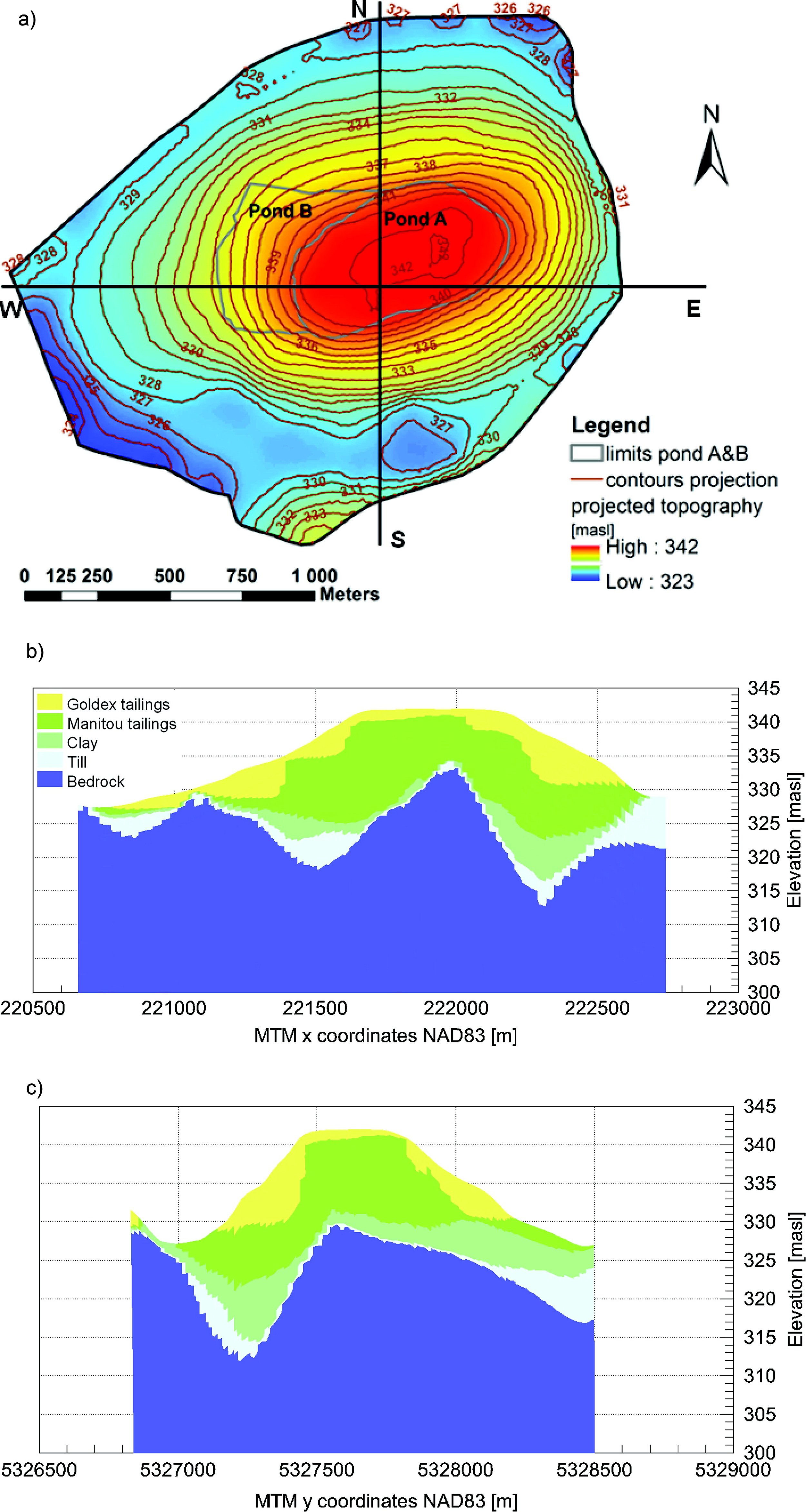HGS RESEARCH HIGHLIGHT – Analyzing variation of the water table level with three-dimensional numerical simulations to assess reclamation techniques for an acidic tailings impoundment
Broda, S., Éthier, M.-P., Blessent, D., Aubertin, M., Maqsoud, A., & Bussière, B. (2021). Analyzing variation of the water table level with three-dimensional numerical simulations to assess reclamation techniques for an acidic tailings impoundment. In Canadian Geotechnical Journal (Vol. 58, Issue 6, pp. 823–833). Canadian Science Publishing. https://doi.org/10.1139/cgj-2019-0694
“The 3D numerical model was constructed and calibrated with (rarely available) monitoring data collected before, during, and shortly after deposition events (which include seasonal variations). The simulations to assess the position of the water table in the long term (100 years) were performed using two different sets of material properties and four precipitation scenarios, based on the characteristics of Manitou tailings sampled in the field and on regional climatic parameters.”
Fig. 9. (a) Projected topography for site closure used for the long-term simulations; in this scenario, the Manitou tailings are covered by up to 10 m of Goldex tailings. Solid black lines indicate location of (b) W–E and (c) N–S cross sections. MTM, Modified Transverse Mercator (NAD83 / MTM zone 9).
CLICK HERE TO READ THE ARTICLE.
As an extension of the last HGS research highlight titled ‘Improving control of contamination from waste rock piles’, this next research highlight within this series looks at a study conducted by the same researchers and explores the effects of thin cover deposition on managing water table levels in acidic tailings impoundments, while utilizing HydroGeoSphere (HGS) for in-depth simulations.
Sulphidic tailings produced during mining operations are highly susceptible to acid mine drainage (AMD) due to their elevated pyrite content. AMD poses significant environmental challenges, as it can lead to the release of harmful metals and acidic waters into surrounding ecosystems. To address this issue, the researchers explored the use of a thin layer of alkaline tailings as a cover material, aiming to control water table fluctuations and reduce AMD. HydroGeoSphere, known for its advanced capabilities in simulating coupled surface water and groundwater interactions, was employed to model these dynamics under various scenarios.
The study revealed that the thin cover was not effective at maintaining an elevated water table, and was therefore unable to significantly mitigate AMD in the short term. By analyzing the interaction between the cover and the underlying tailings, the researchers observed that the cover's alkaline properties did help neutralize acidic leachates, but otherwise was not suitable for maintaining an elevated water table, ensuring that tailings would remain saturated thereby limiting oxidation. The effectiveness of the cover was also found to decrease during prolonged dry periods. This decline is due to increased evaporation rates and reduced water infiltration, which limit the cover's ability to maintain stable, elevated water levels and continuous AMD management.
The researchers also examined the impact of different climatic conditions on the cover's performance. In wet periods, the thin cover demonstrated its ability to manage water table fluctuations and reduce AMD more effectively. Conversely, during dry spells, the cover's ability to manage water levels was compromised, leading to an increase in AMD. In addition to the primary findings, the study assessed the long-term viability of the thin cover approach. The results indicate that while the cover provides immediate benefits, it may not be sufficient for sustained AMD control without supplementary reclamation measures. This is particularly relevant in regions with significant climatic variability, where additional strategies may be required to enhance the cover's performance over time.
Overall, the study provides critical insights into the limitations and potential of thin cover deposition for AMD management in acidic tailings impoundments. By integrating field data with sophisticated modelling, the research offers valuable guidance for developing more effective and resilient reclamation strategies.
Abstract:
Tailings with sulphide minerals exposed to oxygen and water can oxidize and produce acid mine drainage (AMD). This study evaluated the impact of natural conditions and of a thin cover deposition on the water table level, with respect to selecting the reclamation technique to control AMD on the elevated portion of an abandoned tailings impoundment. The reactive tailings were partly covered with alkaline tailings transported as a pulp from a nearby mine. A three-dimensional numerical variably saturated groundwater flow model of the tailings impoundment and its surrounding area was built. The simulation results reproduced well the field observations before, during, and after the deposition of a thin layer of tailings. The calibrated model was then used to forecast the evolution of the water table position for the next 100 years under various site conditions, including a period of 5 years with dry summers. The results show that the water table levels are on average several metres below the interface between the reactive tailings and the cover, thus failing to meet the target criterion to control the production of AMD determined from previous column tests. The results are analyzed and discussed in terms of the site configuration and atmospheric recharge.
“The use of a calibrated hydrogeological 3D model, based on field measurements, to predict the long-term response of the site with the position of the water table is also an innovative approach for evaluation of whether the [elevated water table] is applicable on this portion of the tailings disposal site. It should be noted that, despite calibration in the steady state, the model adequately represented the reality during transient runs.”


